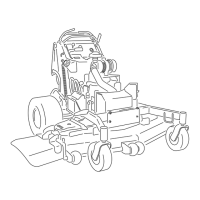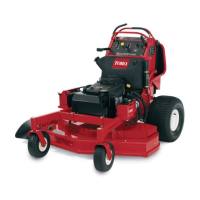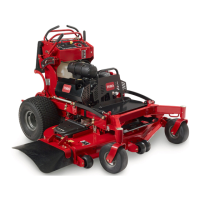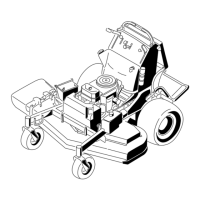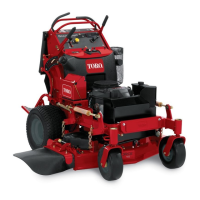T ransporting the Machine
Use a heavy-duty trailer or truck to transport the
machine. Use a full-width ramp. Ensure that the trailer
or truck has all the necessary brakes, lighting, and
marking as required by law . Please carefully read all
the safety instructions. Knowing this information could
help you or bystanders avoid injury . Refer to your
local ordinances for trailer and tie-down requirements.
W ARNING
Driving on the street or roadway without
turn signals, lights, reective markings, or a
slow-moving-vehicle emblem is dangerous
and can lead to accidents, causing personal
injury .
Do not drive the machine on a public street
or roadway .
Selecting a T railer
W ARNING
Loading a machine onto a trailer or truck
increases the possibility of tip-over and could
cause serious injury or death ( Figure 30 ).
• Use only a full-width ramp; do not use
individual ramps for each side of the
machine.
• Ensure that the length of ramp is at least 4
times as long as the height of the trailer or
truck bed to the ground.
g229507
Figure 30
1. Full-width ramp in stowed
position
3. H=height of the trailer or
truck bed to the ground
2. Ramp is at least 4 times
as long as the height of
the trailer or truck bed to
the ground
4. T railer
Loading the Machine
W ARNING
Loading a machine onto a trailer or truck
increases the possibility of tip-over and could
cause serious injury or death.
• Use extreme caution when operating a
machine on a ramp.
• Back the machine up the ramp and walk it
forward down the ramp.
• A void sudden acceleration or deceleration
while driving the machine on a ramp as
this could cause a loss of control or a
tip-over situation.
1. If using a trailer , connect it to the towing vehicle
and connect the safety chains.
2. If applicable, connect the trailer brakes and
lights.
3. Lower the ramp ( Figure 30 ).
4. Raise the platform.
Important: Always keep the platform up
when loading and unloading the machine.
5. Back the machine up the ramp ( Figure 31 ).
25
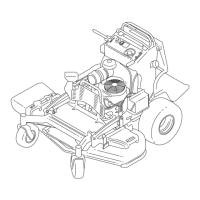
